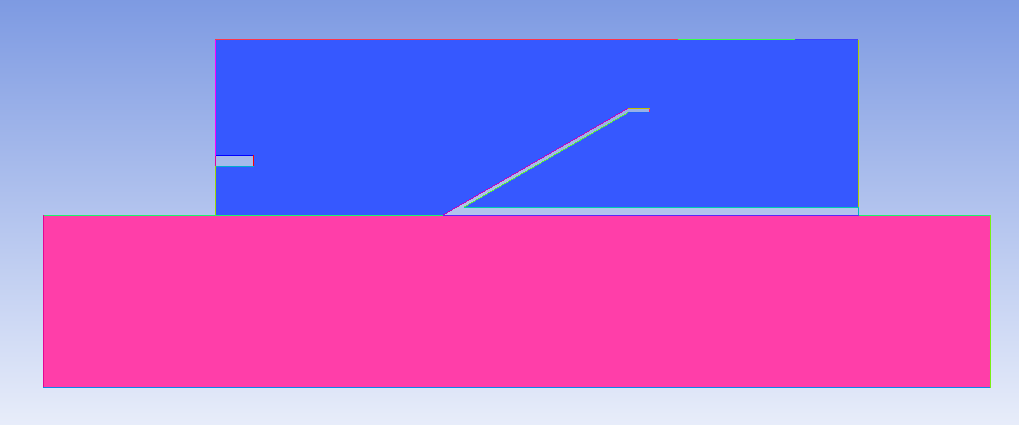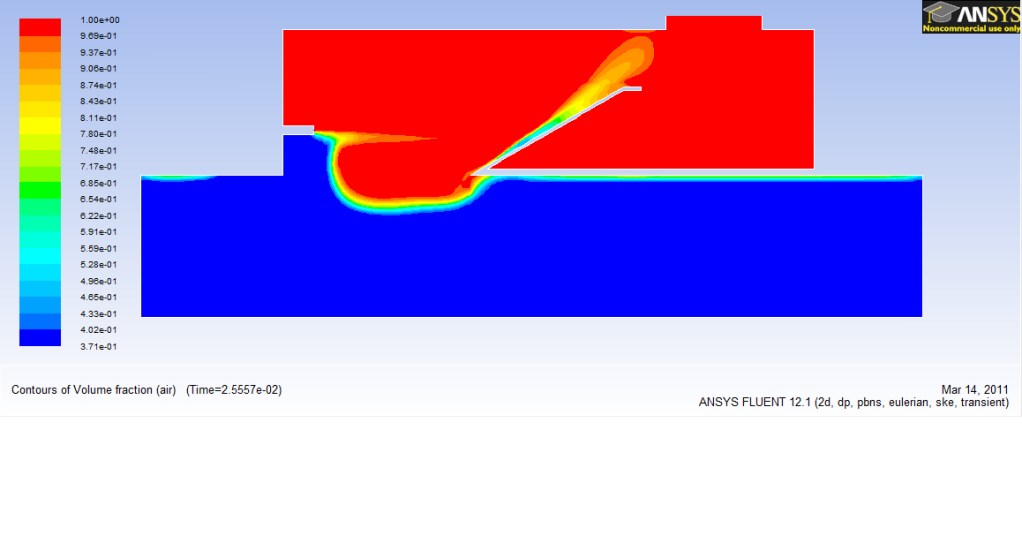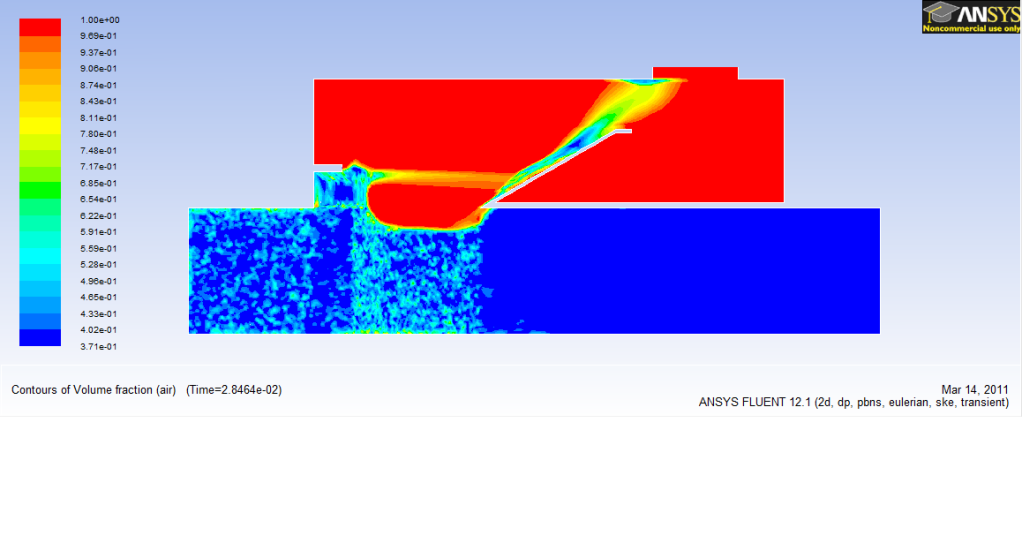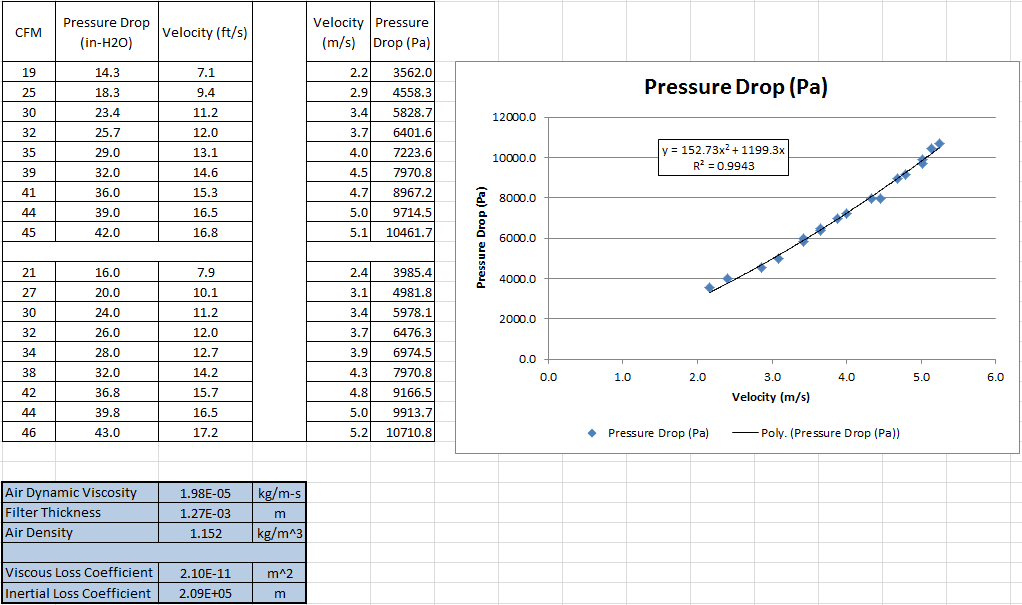 |
|
|
[Sponsors] | |||||
Multiphase Porous Media Flow - Convergence Issues |
 |
|
|
LinkBack | Thread Tools | Search this Thread | Display Modes |
|
|
|
#1 |
|
New Member
Michael
Join Date: Nov 2010
Posts: 23
Rep Power: 16  |
System Description:
Two phase solid-gas flow. The sold being sand particles and the gas is air. Air is injected through a nozzle that entrains the sand particles up a ramp and the mixture hits a filter. The filter ideally filters out the sand particles which drop into a collection area while the air exits the system. A picture of this system can be seen below:  The nozzle is the square portion in the blue region on the left hand side. The end of the rectangle is the velocity inlet. The green line at the top right is where my porous media zone is (No the exact geometry used, but had a picture on hand). The pink is the sand initially and the blue is the air initially. FLUENT Model Details:
Relative Velocity Resistance Formulation Porosity: 0.8
Under Relaxation Factors
I have solved this case without the porous media zone and just using a pressure outlet. My issue was that particulate was flowing out of the outlet and not being collected as desired. The case runs fine until the Volume Fraction becomes anything but 1 (all air) at the porous media zone. An example of the residuals up until this point is shown below:  The volume fraction of air at this point is shown below. The rectangle section at the top right is my porous media zone:  Then I get to this point:  And the residuals begin to flat line or really struggle to converge. What has been tried to remedy the problem:
I did get it converging for a little while but then this happened:  And it diverged very soon after. Any ideas on what I can try? Do all of my settings look correct? Thanks! Mike |
|
|
|

|
|
|
|
|
#2 |
|
New Member
Michael
Join Date: Nov 2010
Posts: 23
Rep Power: 16  |
I have still been working at this to no avail. I doubt my values for the viscous and inertial resistance though. I used a orifice style flow bench to find the pressure drop versus velocity curve. I then fit the curve with a quadratic function and used the coefficients to solve for alpha and C2. However, I'm unfamiliar with "typical" values and am not sure that it is right. Here is my data and the plot. The filter is just a coffee filter so I wouldn't expect it to be too restrictive.

|
|
|
|

|
|
|
|
|
#3 |
|
Member
Byron Smith R J
Join Date: Mar 2009
Location: India
Posts: 46
Rep Power: 17  |
hai
wats the boundary condition imposed on the filter material. u need to create a bc such that only air passes through and sand is retained |
|
|
|

|
|
|
|
|
#4 |
|
New Member
Michael
Join Date: Nov 2010
Posts: 23
Rep Power: 16  |
As far as I know there is no option for such a boundary condition; hence the use of the porous media. If I'm incorrect please let me know.
|
|
|
|

|
|
|
|
|
#5 |
|
Member
Byron Smith R J
Join Date: Mar 2009
Location: India
Posts: 46
Rep Power: 17  |
to selectively transport one component u will have to write UDF
|
|
|
|

|
|
|
|
|
#6 |
|
New Member
Michael
Join Date: Nov 2010
Posts: 23
Rep Power: 16  |
That is one method, but a porous media zone should work as well as you can apply different resistances to each phase. Therefore I apply a large viscous and intertial resistance to the solid phase to prevent it from passing through the porous zone.
I did manage to get the problem to converge and prevent the solid phase from flowing through the porous zone. I removed the visous resistance for air as this should not really be a factor. It is working great, but I have it currently set as a variable time step and to converge it is stepping at 1e-8 seconds. As you can imagine with about 200 iterations per time step this solution is taking a LONG time. Does anyone have any hints/tips to speed up convergence in this case? Thanks, Mike |
|
|
|

|
|
|
|
|
#7 |
|
New Member
Okwoche James
Join Date: Oct 2019
Location: Lagos, Nigeria
Posts: 1
Rep Power: 0  |
Please, how did you arrived at the value of the viscous and inertia resistance?
I really need to find values for the inertia and viscous resistance of fired pottery clay and sand as well. anyone who can help, please? Thanks in advance James |
|
|
|

|
|
|
|
|
#8 | |
|
New Member
roshan
Join Date: Dec 2019
Posts: 10
Rep Power: 7  |
Quote:
if you want to use the pressure-velocity curve for estimation of alpha(m-2),C2(m-0 (two coefficients for porous media) you have to divide pressure by depth of packing the use slope to evaluate alpha and c2. dP/H=alpha*mu*U+(0.5rho*C2*U*U) |
||
|
|

|
||
|
|
|
#9 | |
|
New Member
Liam Jose
Join Date: Mar 2023
Posts: 2
Rep Power: 0  |
Quote:
|
||
|
|

|
||
 |
|
|
 Similar Threads
Similar Threads
|
||||
| Thread | Thread Starter | Forum | Replies | Last Post |
| Porous media setup issues in Fluent | Bernard Van | FLUENT | 29 | January 26, 2017 05:09 |
| multiphase flow in porous media | zhou | FLUENT | 2 | August 9, 2012 08:10 |
| Can LES be used in porous media flow? | Jin | Main CFD Forum | 0 | October 19, 2006 09:50 |
| Simulation of Porous Media Flow | Sharad Dugad | FLUENT | 0 | December 24, 2001 02:57 |
| Help :Porous media flow | Wole | CFX | 7 | August 30, 2001 21:32 |